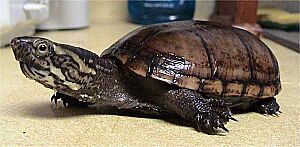Eastern mud turtle facts for kids
Quick facts for kids Eastern mud turtle |
|
|---|---|
 |
|
| Conservation status | |
| Scientific classification | |
| Genus: |
Kinosternon
|
| Species: |
subrubrum
|
The eastern mud turtle (Kinosternon subrubrum) is a common type of turtle. It is also known as the common mud turtle. This turtle belongs to the family called Kinosternidae. These turtles are found only in the United States. There are two main types, or subspecies, of the eastern mud turtle.
Contents
About the Eastern Mud Turtle
What Does It Look Like?
The eastern mud turtle is a small turtle. It is often hard to spot. Its shell, called a carapace, is usually about 3 to 4 cm (1.2 to 1.6 in) long. The carapace is smooth and has no special patterns. Its color can be yellowish or even black.
The bottom part of its shell, called the plastron, is large. It has two hinges, which means it can move in two parts. The plastron can be yellowish or brown. Sometimes, it has dark patterns. The turtle's chin and throat are yellowish-grey. They often have brown streaks. Its legs and tail are greyish. The turtle's eyes are yellow with dark spots. Its feet have webbing, like a duck's foot.
What Does Its Name Mean?
The scientific name for this turtle is subrubrum. This name means "under red". It refers to the red-orange color of the plastron on baby turtles when they first hatch.
What Do Eastern Mud Turtles Eat?
The eastern mud turtle eats many different things. This means it is an omnivore. It eats insects, crustaceans like crabs, and mollusks like snails. It also eats amphibians, dead animals (called carrion), and plants that grow in water.
Smaller eastern mud turtles mainly eat tiny water insects, algae, and carrion. Bigger turtles can eat almost any kind of food they find.
How Do They Move Around?
Eastern mud turtles move between different areas during the year. They might travel from dry, higher lands to wet areas like wetlands. They also move around in the water where they live.
Their home areas can be small or quite large. The size depends on how close their food and shelter are. For example, in places like golf courses, these turtles have been seen crossing different types of land. They do this when they come out during summer and fall.
Where Eastern Mud Turtles Live
Preferred Habitats
Mud turtles, including the eastern mud turtle, live in fresh water. They are found in the southeastern and northeastern parts of the United States. They live in rivers, lakes, and swamps.
These turtles like ponds that have a lot of plants. They also prefer streams that are fed by springs. They like clean water with plenty of oxygen.
Eastern mud turtles rarely sit in the sun. But if they do, they will bask on rocks or floating wood. In the wild, they also like sandy and muddy places. This is because they hibernate by digging into the mud. They prefer to hibernate about 70 meters (about 230 feet) away from wetlands. They like spots with lots of leaves and pine needles. This helps keep the soil moist and the temperature steady.
Adapting to Different Waters
Mud turtles can also live in brackish water. This is water that is a mix of fresh and salt water. So, you might find them near salt marshes or on islands along the coast.
Life Cycle of the Eastern Mud Turtle
Reproduction and Eggs
Eastern mud turtles usually mate in early spring. The female turtles then lay their eggs from May to early June. A group of eggs is called a clutch. Each clutch can have between 2 and 5 eggs.
Bigger female turtles tend to lay more eggs. They can lay at least three clutches of eggs each year.
Incubation and Hatching
How many clutches a turtle lays can change a lot. It depends on how far north or south they live. In warmer places, turtles might lay multiple clutches a year. In cooler areas, they might lay about two clutches per year.
The eggs take about 76 to 124 days to hatch. When a baby eastern mud turtle hatches, its shell is wider than the egg it came from. This means its shell unfolds right after it hatches.
Where They Are Found
The eastern mud turtle lives in many US states. These include Alabama, Arkansas, Delaware, Florida, Georgia, Illinois, Indiana, Kentucky, Louisiana, Maryland, Mississippi, Missouri, New Jersey, New York, North Carolina, Oklahoma, Pennsylvania, South Carolina, Tennessee, Texas, and Virginia.
In the state of Indiana, the eastern mud turtle is considered an endangered species. This means there are very few of them left there.
Health Concerns
In 2014, a disease called ranavirus was found in an eastern mud turtle. This happened in South Carolina. Ranavirus is a serious virus that can affect amphibians, fish, and reptiles.
When an animal gets ranavirus, it can cause sores in its mouth. It can also cause skin problems and eye infections. Sadly, this virus can eventually lead to death for the infected animal.
Types of Eastern Mud Turtles

There are two main types, or subspecies, of the eastern mud turtle:
- K. s. subrubrum (named by Bonnaterre in 1789) – This is the main type, also called the eastern mud turtle.
- K. s. hippocrepis (named by Gray in 1855) – This type is called the Mississippi mud turtle.
There used to be a third type, the Florida mud turtle (K. s. steindachneri). But in 2013, scientists decided it was a separate species on its own.


